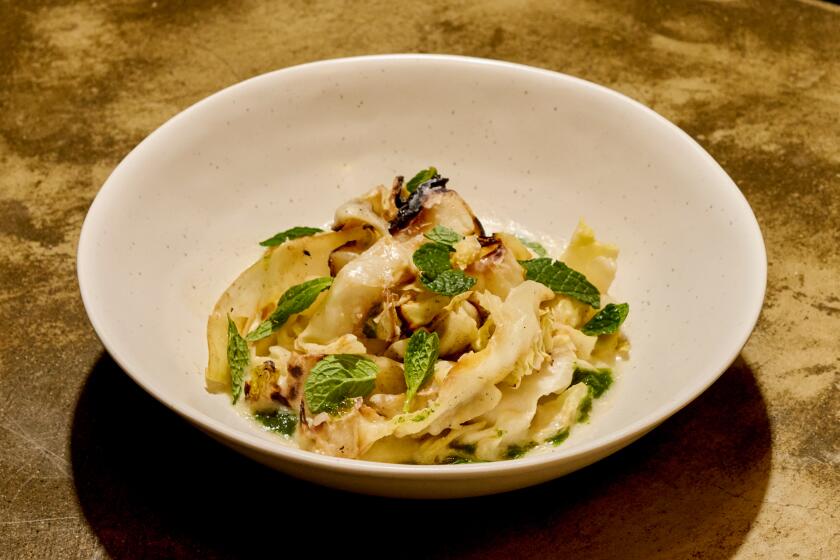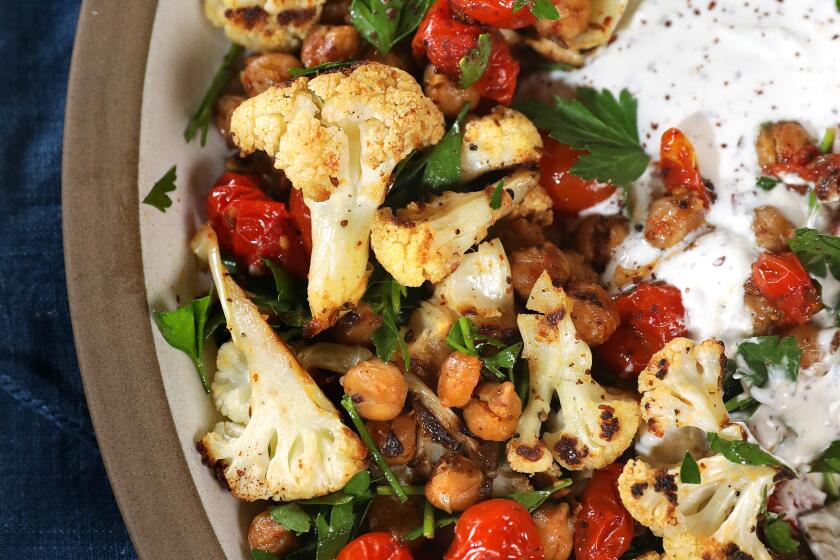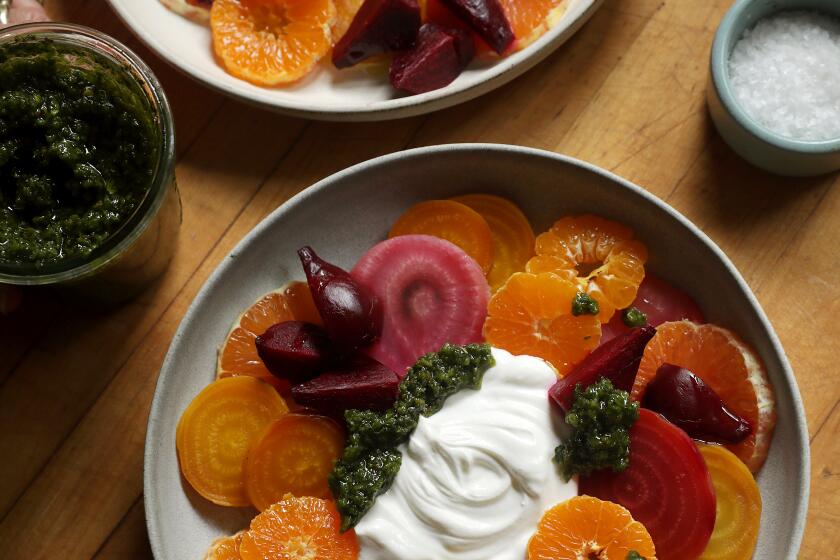Demoniacal potato salad
Hugo Liu says he hates recipes; the whole concept seems hopelessly antiquated to a guy who starts cooking by sniffing spices and thinking. Yet he has invented a revolutionary way of developing them.
He has no formal background in food or drink, only a passion for both. Yet he has developed a radical new method of categorizing both ingredients and wines.
He explores new tastes with a vengeance -- to learn to appreciate kale recently, he consumed it steamed, boiled, sauteed, raw, pureed and even as a cocktail. Yet he believes the future lies in helping other people make food decisions not by mouth but with the click of a mouse. Give him your last few meals and he can virtually map your taste buds.
Escoffier would be addled by the very notions, but this 27-year-old, spiky-haired computer whiz at the MIT Media Lab here in Cambridge is starting to shake up the food world with a combination of artificial intelligence and natural obsession. Any geek could run 160,000 recipes on the Internet through a software program to deconstruct them. How many would think to sort them not by course or ingredient or even technique but by that most ineffable of quantifiers: emotion?
His first big project, a searchable database called the Synesthetic Cookbook, brought Liu to national attention two years ago. He is still trying to explain it -- most recently at food-world conferences in Napa and West Virginia, where both times he caused a stir -- while moving on to more daring concepts. His latest computer project, “Gulp Fiction,” creates recipes to order.
“Hugo was like a wet finger in an electric socket,” says Antonia Allegra, who organized a food writers conference at the Greenbrier in West Virginia in May and booked Liu after hearing him speak at the Taste 3 forum in the Napa Valley earlier this year. “People who didn’t understand a word knew what he was saying was very important.”
Allegra, who described Liu as “the most other-worldly speaker we have ever had,” adds, “If what Hugo is saying and doing is feasible, it won’t be necessary to have a human writing recipes in the next five to eight years.”
Liu has many other ideas on his plate beyond sparing cookbook writers weeks over a hot stove, however. In applying artificial intelligence to aesthetics, he says his overall goal is to “help people become fluent in taste.” And he is clearly equipped with one of the more free-ranging minds in food today. Whereas Harold McGee brought rigorous science to bear on food, Liu contributes a combination of linguistics, imagination and fascination.
Within minutes of meeting him, he might be cupping his hand over his ear, asking whether “you listen to what your body is asking” and launching into a mini-lecture on how rats understand innately what to eat to keep themselves healthy. He might be offering you herring-shaped Dutch salted licorice and noting that it is among the few licorice products that actually contains the pungent root. And he will definitely be explaining that what drives his interest in food is a desire for connoisseurship, plus the fact that “I have a lot of vices: I eat foie gras too often for my heart; I smoke pipe tobacco; I drink lots of Scotch and sake.”
Liu is not your average food firebrand. He was born in China and lived there until he was 6. His parents, who both worked for the United Nations, had family roots in different regions of the country, which meant he grew up with rice on his father’s side and noodles on his mother’s. He received his doctorate in media arts and sciences from MIT in June 2006 (as an undergraduate, he minored in baroque music).
Among the groundbreaking projects that caused a sensation at the Greenbrier are what Liu calls Taste Spaces, essentially “maps” of a sort of solar system of different kinds of foods and wines. By parsing descriptions online (32,000 of wine alone), he groups Champagne with Muscat, Gewerztraminer and Tokay. Morels are grouped with wasabi and poblano chiles; foie gras with Cognac and ambrosia; and olives with durian and shiitakes. Human intelligence would balk, as Liu has found, particularly among longtime food writers, but sorting them by common descriptions or contexts online simply puts them together.
He can draw up a similar map of a food writer’s taste buds by running recipes or articles through his program and determining which ingredients and words turn up most often.
On a recent afternoon, given his choice of anywhere for lunch, Liu suggested a cab to the nearest Whole Foods, where he loaded a basket with a platter of local barbecue, an oozy wedge of Reblochon cheese and a bottle of artisanal kimoto sake, all to be eaten and drunk off plastic in the picnic seating area. He admits he was a picky eater until recently but has decided there are three A’s to be mastered as a sophisticated consumer: acclimate (eat kale every which way), appreciate (decide it tastes good) and associate (describe it well enough to persuade someone else to try it).
And it is the last verb that matters most to him, with his background in computational linguistics and his belief that “good tasters have to know not just words but be able to conjure meaning.” He describes his favorite sake as “tasting like Carnation Instant Breakfast” but says someone else might note bananas, or even the heat of a banana boat. One day, he imagines, “customers could order words, not food -- ‘Bring me some whimsical.’ ”
Liu says he found recipes extremely easy to parse in producing “The Synesthetic Cookbook,” which analyzes 160,000 recipes “clipped” from the Web and broken down by 5,000 keywords for ingredients and 1,000 for descriptions (spicy, tasty). A user searching the database, which is behind an MIT firewall today, could call up a screen with a plate on it and order dinner ideas for the whole family. “Beef” would bring up countless possibilities but could be refined with “spicy,” “herbaceous” and, especially, “comforting.” Individual family members’ likes and allergies could also be plugged in to decide on a dish.
The “cookbook” is a revelation not so much for the recipes, though, as for how they are ultimately summoned. Synesthetics is the physiological process in which a sensation elicits an emotion (or a sip of wine evokes a color), and Liu’s unique original work contains 980,000 aesthetic associations and 100,000 contexts, or emotions.
But while his first “cookbook” draws on recipes already in existence, ones any computer user could find by the literal thousands on sites such as epicurious.com, “Gulp Fiction” is a leap into uncharted terrain. It reflects Liu’s interest in collecting “words and virtualities -- uncooked recipes and imagined foods,” hence the title.
The user of this program can have it write a recipe, selecting from essences Liu has programmed as being necessary to make a French, or a Cajun, or a Japanese dish. The fun is in the context: A request for “sad” oatmeal produces a recipe with red wine, beer, gin, vodka, brandy and soda; “poetic” pizza has no crust; “pensive” deviled eggs call for apricot preserves.
Judging by a demonstration in Liu’s tiny shared office in the Media Lab, “Gulp Fiction” at this point is more “textual eating,” as he describes it, than cooks’ miracle. Ask it for an enchilada recipe, he explains, and it will produce “not any enchilada recipe but an essence of all enchilada recipes -- it doesn’t copy any recipes.” The ingredients it lists will need some pruning (“1/2 small Chinese,” for instance, is not likely to be found in most refrigerators), and while its directions are lyrical and almost hypnotic, they are also whimsical to the point of nonsensical: “Sift the salt. Wash the bay leaf. Red the white pepper. Cheese the mayonnaise.”
A halfway-seasoned cook can make a dish from “Gulp Fiction” work, however. And the program does combine ingredients even a thoroughly seasoned cook might not think to bring together in one bowl: shiitakes, anchovies and watercress in potato salad, say, or white chocolate, green tea powder, rose petals and cherries in ice cream.
Liu considers his latest work “food conjuring” and admits that “I get a kick out of reading this, but the kitchen chemistry has not kicked in.” In short, it is not dissimilar from what many Internet junkies would call food porn, dishes to be drooled over rather than actually eaten.
“You can never take people out of the equation,” Liu says. “But this takes the dull work out of their hands. It helps them focus on what humans are really good at.” And that, he says, is more “testing than generating” recipes.
So why, given his cyberific devotion to them, does he hate recipes? “Why do you like speaking in fresh sentences?” he responds. “Recipes used to be handed down. They used to mean something. They meant something when it was Yaya’s home cooking, but that’s not what it means anymore. Someone you don’t know is telling you something, and you don’t know if you should trust them.”
Now, a computer that understands you’re hungry for elation -- that is a whole different dinner.
Place the potatoes in a pot and add 1 teaspoon salt and cold water to cover. Cover, bring to a boil and cook until easily pierced.
While the potatoes cook, heat the oven to 400 degrees. Toss the shiitakes with 1 tablespoon of the oil and salt and pepper to taste. Spread on a baking sheet and roast 10 minutes, stirring occasionally. Remove from the oven and cool, then cut each one in half.
To make the dressing, combine the vinegar, lemon juice and mustard in a bowl and blend well. Whisk in the remaining 2 tablespoons olive oil, then the mayonnaise, until smooth. Add the sugar and anchovies and blend well. Season with salt and pepper to taste.
When the potatoes are cooked, drain well and dry. Cut each into quarters and place in a large shallow bowl. Add the shiitakes, cucumber and onions and toss to mix, then add the dressing and mix well. Let stand 15 minutes. Just before serving, add the watercress and toss to mix well.
Get our Cooking newsletter.
Your roundup of inspiring recipes and kitchen tricks.
You may occasionally receive promotional content from the Los Angeles Times.













